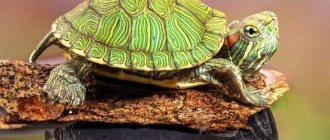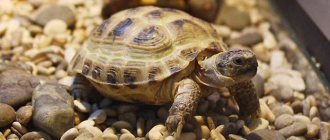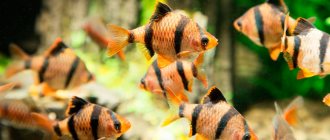When keeping a land turtle at home, it is important for the owner to know how to properly care for it. Land turtles are quite unpretentious pets, but unsuitable housing conditions significantly shorten the life of the reptile. To keep your turtle healthy and active, you need to give it a little attention and properly care for it.
The most common mistake among tortoise owners is that they do not require care. This is partly true. These reptiles do not require daily care and attention, but they still need to be monitored. If not properly cared for, the turtle can get sick, hibernate, or even die. To prevent this from happening, you should create comfortable living conditions for her and monitor her appearance.
How to properly care for a land turtle, what are the owner’s responsibilities?
- Purchase and proper arrangement of a terrarium.
- Cleaning the terrarium.
- Creation of optimal conditions for maintenance.
- Taming a turtle.
- Preparing the right diet.
- Bathing a turtle.
- Walks in the summer.
- Trimming claws and beaks.
- Treatment for diseases.
Terrarium and its arrangement
To keep a land turtle you need to purchase a terrarium. For a number of reasons, you should never leave a turtle to live on the floor. A pet can catch a cold due to drafts “walking” across the floor, it can get stuck and get damaged, and dust that clogs the airways also negatively affects its health.
Land turtles love to burrow and hide in secluded places. You may not notice and accidentally step on a turtle. In the best case, it will receive damage of varying severity; in the worst case, it can be crushed.
- The minimum size of the terrarium is 80x50x40 cm.
- The bottom of the terrarium must be covered with soil 10-15 cm thick.
- Inside the terrarium you need to install a heating lamp and a UV lamp.
- Be sure to put up a house, which is needed as a shelter.
Many owners do not consider it necessary to install a UV lamp, which is why turtles often suffer from rickets. The UV lamp helps produce vitamin D, which makes calcium better absorbed in the body.
What to feed a red-eared slider?
Due to the fact that these creatures are omnivores, their owners do not have to work hard. You just need to monitor the balance of the red-eared slider’s diet.
A healthy diet includes vegetables and fruits, aquarium plants, fish, insects, invertebrates, etc. You should not feed your pet exclusively with artificial (store-bought) food for red-eared turtles. Also make sure that the animal receives a sufficient amount of calcium and in no case overeats (this can lead to obesity).
Quadrupeds drink water in order to swallow food: after all, they do not produce their own saliva. You need to feed turtles every other day or two (adults over a year old) and every day (babies).
Turtles eat in the water. If you want to keep the liquid in the aquarium clean for a longer period, you can feed your pets in a separate container.
Cleaning
One of the important rules for caring for a land turtle is cleanliness in the terrarium.
You need to clean the terrarium once a week. Cleaning includes washing the walls of the terrarium, house, stones, and decorative elements. Do not use products with chemical composition. You can add soda or soap solution to the water.
The soil must be replaced as it becomes dirty. The more the owner feeds the turtle, the more it defecates. Most often, the soil needs to be replaced for young turtles. Until they are two years old, they need to be fed daily. Adult turtles are fed once every 2-3 days, so they defecate somewhat less frequently than young turtles.
The bowl and drinking bowl must be washed daily. If the turtle has not eaten all the food offered, then the remains must be removed from the terrarium. Otherwise, flies and other parasites may appear.
It happens that parasites start in the soil. Then it is completely removed from the terrarium and calcined in the oven for 20-30 minutes.
Options for keeping a pet reptile
Turtles are not rare pets, and they are often found among private owners. In addition, it is rare that a zoo, aquaterrarium or animal corner can do without such inhabitants. Often, owners keep their shelled pets in the same way as other pets, allowing the turtle to crawl freely around the house. They place bowls for food and water and even try to introduce the reptile to the tray. That is, the animal remains free and, of course, does not leave the home.
But is such a free life suitable for the turtles themselves? Most zoologists believe that such a situation is unacceptable. You cannot identify a reptile with cats or dogs; it is too different from them, and not only in appearance.
While free, the turtle is in constant danger. She may start eating small debris, get stuck in some device, or get a cold after being in a draft. In addition, there are often cases when the owners themselves stepped on their pet or tripped over its shell. To avoid tragic situations, you should provide your pet with a safe territory - a spacious terrarium, where it will be comfortable and convenient to live.
Feeding
Caring for a turtle also includes preparing a diet and properly feeding the land reptile. The diet of a land turtle should consist of greens, vegetables, fruits, porridge and vitamins. 70-80% of the diet should be plants and greens.
Grass can be collected in summer in a meadow or forest away from the road. Among the greens, turtles can be given dandelion, plantain, clover, lettuce, sorrel, rhubarb, and chamomile.
Juicy food is also necessary in the diet. It is rich in vitamins and contains fiber, which aids digestion. The land turtle can eat cucumbers, zucchini, bell peppers, bananas, pears, and apples.
We have already reviewed a complete list of products for the land turtle in the article “What does the land turtle eat.”
Turtles also need water. The drinking bowl should be of such a size that the reptile can fit completely inside. The water level should reach the middle of the shell, otherwise the pet can easily choke.
As a drinking bowl, you need to use a heavy container with low sides. It is best to dig it a little deeper into the ground so that the turtle cannot turn the container over.
It should be taken into account that the reptile will defecate directly in the drinking bowl. Therefore, it is necessary to monitor the purity of the water; if necessary, the drinking bowl should be washed and clean water should be poured.
Coating the bottom of the container
It is covered with soil or a bedding of hay. In the first case, the particles of material must be large so that the turtle does not eat too many pebbles. The second option is more summer, since it is not so easy to find hay in winter. It is allowed to fill the bottom with sand, but some reptiles eat it. If such behavior is typical for your pet, then it is better to refuse sand.
Another option is to add a layer of sand and lay a layer of large pebbles on top of it - the pet will sharpen its claws on them. Some species love to burrow, in which case it is worth putting more material in the tank for the turtle to enjoy. You should not use pieces of paper, expanded clay particles, sharp gravel, or litter intended for cat litter boxes, even wood, as soil.
Bathing
It often happens that a turtle's skin dries out and peels. The bathing process is one of the important components when caring for a land turtle. Bathing a reptile saves the body from dehydration and helps replenish and normalize the water balance in the body.
The water must be warm, 30-35 degrees. You can bathe your turtle 2-3 times a month. It must be placed in a container with water and left for 20-30 minutes. During the procedure, you need to monitor her so that she does not roll over onto her back.
After bathing, the turtle should be dried with a towel and placed in a terrarium. You should not let the reptile go wet, it may catch a cold.
If the reptile's skin is dry and flaking, then a non-greasy reptile cream is rubbed into the skin and shell for a week.
Caring for aquarium turtles
Freshwater turtles are also very popular. Turtles of this species can often be found in warm waters. They are small in size and bright in color.
Feeding
Many species of freshwater turtles are omnivores, but that doesn't mean you have to share your lunch with them. They mainly eat food for turtles, fish, pieces of raw meat and fish, and vegetables. In the process, you yourself will understand what to feed your turtle. Mineral supplements in the form of calcium are also necessary.
Content
Freshwater turtles are kept in a terrarium. It must be equipped with a lighting, ventilation and heating system. In addition to water, the terrarium should have a plot of dry soil. The turtle must be able to swim freely and go onto land if necessary.
The size of the terrarium depends on the size of the turtle. For sushi, soil or smooth stones are suitable; it is important that it can climb onto a dry place without difficulty. Lighting is usually installed there so that the turtle can bask.
Gravel and smooth pebbles are excellent for the ground, but you can also use mats. They imitate grass. You can also place some large smooth stones, pottery and driftwood into the terrarium for decoration. The water temperature should be from 17 to 30 degrees.
Water Turtle Health
If the turtle begins to eat little or refuses to eat at all, and often begins to swim near the bottom or on its side - these are signs of poor health. And this, in any case, is a clear signal to go to the vet.
Trimming claws and beaks
In nature, turtles independently wear down their beaks and claws on stones and hard food. At home, reptiles do not always have time to grind down their claws or beaks before they grow too much.
The owner must care for and monitor the appearance of the turtle. An overgrown beak causes severe discomfort to the reptile, as it prevents it from eating.
The owner can independently trim the reptile's claws and beak using nail clippers. To trim the claws, you need to step back 2-3 mm from the blood vessels and carefully pinch off the excess.
In order to shorten the turtle's beak, you need to take it by the neck and carefully fix the head between your fingers. Nibble a little under the upper jaw with tweezers until normal. The main thing is to ensure that the turtle has the correct bite.
Appearance
A turtle at home is exotic, and its appearance is also unusual.
Animal body:
- head and eyes;
- neck;
- beak and tongue;
- shell;
- color;
- limbs;
- tail;
- dimensions.
The head of these reptiles is streamlined and designed in such a way that the animal can quickly pull it under its shell. In some species, the length of the neck is equal to the length of the shell.
These animals have a strong and hard beak with bulges inside, with sharp or jagged edges that act as teeth.
The function of the shell is protection. The dorsal (upper) part is called the carapace, the ventral (lower) part is called the plastron.
The size of a turtle is measured by the length of its shell. Determine the length using a ruler despite the fact that the surface of the dorsal part is uneven.
They grow slowly throughout life. In adult individuals, the length of the carapace is 20–30 cm.
The tail is hidden inside the shell. The tip of the tail in some species is pointed, similar to a spike.
Differences between Central Asian and red-eared cats in appearance
| Appearance | Central Asian | red-eared |
| Color | Yellow-beige color, shapeless dark spots on the shell. | The carapace has characteristic stripes of olive, black, and yellow colors. |
| Plastron | Dark color. | Smooth, variegated color: dark spots on a yellow background. |
| Head | The upper jaw is hooked. | From the eyes to the neck, on both sides there are yellow-red lines resembling ears. |
| Eyes | Located on the sides of the head in such a way that they look down; small, black. | Directed forward and upward, located near the crown. |
| Limbs | The front paws are flat, designed to dig soil, and the hind paws are powerful and strong. They have four toes on their front paws with blunt claws. | The feet have leathery membranes for swimming. |
| Dimensions | Cubs are born 3–3.4 cm long and weigh 10–12 grams. By the second year of life, the size will increase to 5 cm, by the fourth to 9 cm. The weight of an adult turtle grows to 2 kg. | A newborn cub is 2.4 cm long, and during the first year of life it gains 2.5–4.5 cm. At two years, its size will be 8 cm, at six years - 18 cm. |
Sense organs
Turtles have good low-frequency hearing and excellent color vision.
Red-eared turtles have an excellent sense of smell and smell. They see both in water and above water. Hearing is like that of cats: they can distinguish dull sounds and vibrations. Nerve endings pass through the shell. Animals with a sense of touch distinguish the taste of food.
Aquatic turtles are not adapted to breathe underwater; they swim up for oxygen.
Lifespan
The average lifespan of these animals in their natural environment is 20–30 years. If kept at home, if the rules of care are followed, pets will live up to 40-50 years.
In captivity, these reptiles grow faster as they receive high-quality nutrition and a comfortable life.
When determining age, they are guided by size and also count the number of rings on the shell. In one year, 2–3 rings are formed. But this growth is not uniform; it is influenced by conditions of detention, illness, and hibernation.
In older individuals, the carapace is smooth, the growth rings are pale. The younger the turtle, the brighter its color.
Inappropriate maintenance and disease are the main causes of death.
In another article, we took a closer look at how long turtles live.
Walks
In the summer, the turtle must be walked. To prevent the turtle from running away and getting lost, it is necessary to build an enclosure or fence for it. It is very important to deepen the fence a few centimeters into the ground, since turtles like to burrow into the grass or soil.
Despite the slowness of the land turtle, it is easy to overlook and get lost in the grass. Therefore, you should keep an eye on her while walking.
Do not leave your turtle in direct sunlight. She must have a dark or secluded place where she can hide.
conclusions
Before getting a yellow-bellied reptile, you need to re-read the description of the article in detail again; a red-eared turtle may die if environmental conditions do not meet its needs. Keeping turtles requires knowledge of care information and the availability of all the necessary equipment for a comfortable habitat for the red-eared representative. To keep a reptile, it is necessary to provide the aquatic environment and land surface, the proper temperature, and also take care of the cleanliness of the home when keeping it at home.
Taming
Land turtles are very popular pets. They are especially in demand among the category of people who want to have a pet, but do not have free time. The ideal solution in such a situation is to purchase a land turtle.
These reptiles are not only unpretentious in maintenance and do not require care, but they are also solitary by nature. Land turtles do not need to be kept in pairs. Usually a turtle of the opposite sex is placed with another only for mating, otherwise conflicts may arise.
Taming a land turtle is not difficult. They are quite friendly to humans and rarely show aggression. Taming can begin by hand-feeding the turtle.
A leaf of greenery or a piece of fruit should be held between your fingers and handed to the turtle. You should be careful, the turtle may bite your fingers painfully. You can also come up with a nickname for the turtle and call it to feed.
Caring for a land turtle at home will not cause much trouble. However, you need to keep an eye on any pet. Any changes in appearance may indicate symptoms of the disease. The most common disease in land turtles is rickets. It is expressed in the curvature and softening of the shell. Any disease significantly reduces the lifespan of animals. Therefore, it is important not only to create comfortable living conditions, but also to properly care for the turtle.
Purchase
Before getting a turtle, read the description of care features and purchase everything you need to ensure a comfortable life. Be prepared for additional costs associated with keeping turtles in your home.
After purchasing, take your turtle to the vet. He will determine the age and sex of the animal, and examine it for wounds, injuries, infections, and diseases.
In a new place, the turtle will need an adaptation period to get comfortable. Do not disturb her again, provide proper care and nutrition.
If you acquire a new animal for company living, organize a quarantine zone for the newcomer for three months. Do not place cubs with adults, they will be injured. Only animals that are similar in size and living conditions can be combined in one space.
Expenses
In addition to a terrarium or aquarium with additional equipment, a heating lamp, include in the cost of good quality food, examination or treatment by a veterinarian.
What to look for when choosing a turtle
Although land reptiles are much easier to keep than aquatic or semi-aquatic ones, the brighter, cheaper and more popular aquarium turtles are more likely to attract attention. What nuances should be taken into account when choosing a four-legged inhabitant?
- If you don’t have experience keeping such animals, it’s better to buy teenage turtles - they get sick less often than kids.
- It is advisable to make the purchase in the warm season - then during transportation there is a higher chance of not catching a cold on the reptile.
- It is better to start getting acquainted with these pets with the simplest species - red-eared turtles, swamp turtles, trionics, postponing until the right time the idea of breeding more complex reptiles, for example, large fringed turtles - the more exotic the species, the more effort must be made to maintain it.
- In individuals whose size does not exceed 10 cm, it is impossible to determine the sex, so you can safely take the one that you like more than the rest.
Choosing the right pet is important, but even more important is preparing everything necessary for its comfortable living in captivity.











